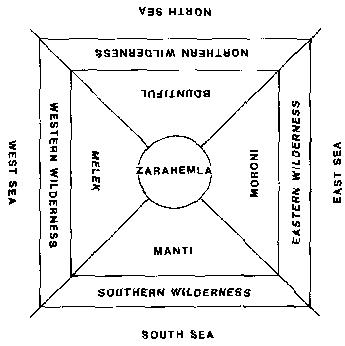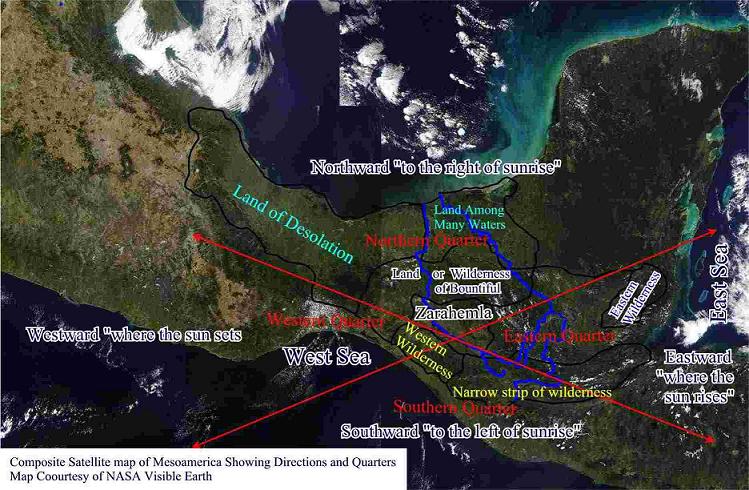
FAIR is a non-profit organization dedicated to providing well-documented answers to criticisms of the doctrine, practice, and history of The Church of Jesus Christ of Latter-day Saints.
GregSmithBot (talk | contribs) m (GLSBot: Adding footers to all articles) |
m (→top: Bot replace {{FairMormon}} with {{Main Page}} and remove extra lines around {{Header}}) |
||
| (9 intermediate revisions by 4 users not shown) | |||
| Line 1: | Line 1: | ||
{{ | {{Main Page}} | ||
{{BoMGeoTableStart}} | {{BoMGeoTableStart}} | ||
{{BoMGeo:Poulsen 2004_RAW}} | {{BoMGeo:Poulsen 2004_RAW}} | ||
| Line 6: | Line 6: | ||
{| <!--Second table; can probably start any additional text below it--> | {| <!--Second table; can probably start any additional text below it--> | ||
|- | |- | ||
|Lawrence Poulsen, stimulated by the models proposed by Sorenson and Hauck, used his own study of the text, combined with advances in 3-D computer mapping technology and satellite maps to provide a fascinating refinement of the Mesoamerican model.{{ | |Lawrence Poulsen, stimulated by the models proposed by Sorenson and Hauck, used his own study of the text, combined with advances in 3-D computer mapping technology and satellite maps to provide a fascinating refinement of the Mesoamerican model.<ref>Lawrence Poulsen, ''bomgeography.poulsenll.org''{{link|url=http://bomgeography.poulsenll.org}}</ref> <br> Poulsen compares Sorenson's River of Sidon suggestion (the Grijalva River) with Hauck's (the Usamacinta River) and finds Grijalva much more plausible.<ref>Lawrence Poulsen, "A comparison of the river Sidon, as referenced in the Book of Mormon, to the Grijalva River found in Chiapas, Mexico,"''bomgeography.poulsenll.org''{{link|url=http://bomgeography.poulsenll.org/grijalvasidon.html}}</ref> Poulsen extends this analysis to show how the explorers mentioned in {{s||Mosiah|8|7-10}} likely mistook Usamacinta for Sidon/Grijalva, thus becoming hopelessly lost. The Book of Mormon text is even accurate in the direction which the Sidon flows at a critical point.<ref>Lawrence Poulsen, "Why did King Limhi's search party get lost in the wilderness?," ''bomgeography.poulsenll.org'' (accessed 17 September 2006). {{link|url=http://bomgeography.poulsenll.org/tworivers.html}}</ref> <BR> | ||
| Line 13: | Line 13: | ||
This Cumorah candidate is about 110 miles north of Tepetzintla (which, at 4040 feet high he identifies as a potential [http://maps.google.com/maps?f=q&hl=en&q=21%C2%B0+15%27+00.00%22,+-97%C2%B0+51%27+00.00%22&ie=UTF8&z=8&ll=21.303449,-97.849731&spn=2.19537,5.493164&t=k&om=1 Hill Shim]). | This Cumorah candidate is about 110 miles north of Tepetzintla (which, at 4040 feet high he identifies as a potential [http://maps.google.com/maps?f=q&hl=en&q=21%C2%B0+15%27+00.00%22,+-97%C2%B0+51%27+00.00%22&ie=UTF8&z=8&ll=21.303449,-97.849731&spn=2.19537,5.493164&t=k&om=1 Hill Shim]). | ||
Interestingly enough, Tepetzintla translates to ''Cerro de Maiz'' in Spanish or "Corn Hill" in English, which has been suggested as the meaning of the Hill "Shim."{{ | Interestingly enough, Tepetzintla translates to ''Cerro de Maiz'' in Spanish or "Corn Hill" in English, which has been suggested as the meaning of the Hill "Shim."<ref>Bruce Warren, "Surviving Jaredite Names in Mesoamerica," ''meridianmagazine.com'' {{link|url=http://www.meridianmagazine.com/ancients/050526mesoamerica.html}} '''Note''': Some Mesoamerican experts consulted by FAIR have recommended caution in accepting Warren's conclusions regarding names. This link is included because it forms part of the basis for Poulsen's suggestion.</ref> (Shim was the Jaredite hill identified by the Nephites as likely being in the same locality as "Cumorah"—see {{s||Mormon|1|3}}, {{s||Mormon|4|23}}; compare with {{s||Ether|15|11}}, {{s||Mormon|6|6}}). | ||
Poulsen suggests [http://maps.google.com/maps?f=q&hl=en&q=santa+rosa,+guatemala&sll=38.451976,-122.713165&sspn=0.115343,0.343323&ie=UTF8&z=6&ll=17.727759,-88.110352&spn=8.969893,21.972656&t=k&om=1 Santa Rosa] for the city of Zarahemla. | Poulsen suggests [http://maps.google.com/maps?f=q&hl=en&q=santa+rosa,+guatemala&sll=38.451976,-122.713165&sspn=0.115343,0.343323&ie=UTF8&z=6&ll=17.727759,-88.110352&spn=8.969893,21.972656&t=k&om=1 Santa Rosa] for the city of Zarahemla. | ||
Furthermore, Poulsen suggests the use of a "quadrant"-based directional system as used by some Mesoamerican groups,{{ | Furthermore, Poulsen suggests the use of a "quadrant"-based directional system as used by some Mesoamerican groups,<ref>Lawrence Poulsen, "Directions in the Book of Mormon," ''bomgeography.poulsenll.org'' (accessed 17 September 2006). {{link|url=http://bomgeography.poulsenll.org/bomdirections.html}}</ref> as opposed to arguing that the Nephites used cardinal directions off-set from magnetic north, as Sorenson does.<ref>See Sorenson's discussion in {{FR-6-1-10}} See also wiki link [[Book_of_Mormon_geography/Models/Limited/Sorenson_1955|here]].</ref> <br> Clark's review of Hauck contained a similar suggestion that the Nephites conceptualized their world in a quadrant-based fashion (see image at right). | ||
<br> | <br> | ||
<br> | <br> | ||
||[[Image:Clark-Figure8-ConceptualizedBoM-world.JPG|right|frame|Clark's suggestion for how Nephites conceptualized their world.{{ | ||[[Image:Clark-Figure8-ConceptualizedBoM-world.JPG|right|frame|Clark's suggestion for how Nephites conceptualized their world.<ref>From {{FR-1-1-7}}; Figure 8 {{link|url=http://farms.byu.edu/review/01_1989_07h.html}}</ref>]] | ||
|- | |- | ||
|} | |} | ||
| Line 26: | Line 26: | ||
{| | {| | ||
|- | |- | ||
|[[Image:PoulsenQuadrants1.jpg|frame|Satellite map with Poulsen's quadrant-based geography overlaid. The Grijalva/Sidon river is the blue line on the left; to the right is the Usamacinta.{{ | |[[Image:PoulsenQuadrants1.jpg|frame|Satellite map with Poulsen's quadrant-based geography overlaid. The Grijalva/Sidon river is the blue line on the left; to the right is the Usamacinta.<ref>Lawrence Poulsen, "Directions in the Book of Mormon," ''bomgeography.poulsenll.org'', Figure 5 (accessed 17 September 2006). {{link|url=http://bomgeography.poulsenll.org/bomdirections.html}}</ref>]] | ||
|- | |- | ||
|} <!--In table to prevent text scrolling around in ugly fashion. Replace <br> codes if more text added; this just keeps it looking nice without being centred and lots of white space above the first line in the table.--> | |} <!--In table to prevent text scrolling around in ugly fashion. Replace <br> codes if more text added; this just keeps it looking nice without being centred and lots of white space above the first line in the table.--> | ||
{{Endnotes label}} | |||
<references /> | |||
Contents |
| Model Name | Date Proposed | Scope | Narrow Neck | Land North | Land South | Cumorah | River Sidon | Nephi's Landing | Religion | Type of model
Model name: Poulsen 2004Date proposed: 2004 |
|---|
| Lawrence Poulsen, stimulated by the models proposed by Sorenson and Hauck, used his own study of the text, combined with advances in 3-D computer mapping technology and satellite maps to provide a fascinating refinement of the Mesoamerican model.[1] Poulsen compares Sorenson's River of Sidon suggestion (the Grijalva River) with Hauck's (the Usamacinta River) and finds Grijalva much more plausible.[2] Poulsen extends this analysis to show how the explorers mentioned in Mosiah 8꞉7-10 likely mistook Usamacinta for Sidon/Grijalva, thus becoming hopelessly lost. The Book of Mormon text is even accurate in the direction which the Sidon flows at a critical point.[3]
This Cumorah candidate is about 110 miles north of Tepetzintla (which, at 4040 feet high he identifies as a potential Hill Shim). Interestingly enough, Tepetzintla translates to Cerro de Maiz in Spanish or "Corn Hill" in English, which has been suggested as the meaning of the Hill "Shim."[4] (Shim was the Jaredite hill identified by the Nephites as likely being in the same locality as "Cumorah"—see Mormon 1꞉3, Mormon 4꞉23; compare with Ether 15꞉11, Mormon 6꞉6). Poulsen suggests Santa Rosa for the city of Zarahemla. Furthermore, Poulsen suggests the use of a "quadrant"-based directional system as used by some Mesoamerican groups,[5] as opposed to arguing that the Nephites used cardinal directions off-set from magnetic north, as Sorenson does.[6] |
 |
 |

FAIR is a non-profit organization dedicated to providing well-documented answers to criticisms of the doctrine, practice, and history of The Church of Jesus Christ of Latter-day Saints.
We are a volunteer organization. We invite you to give back.
Donate Now